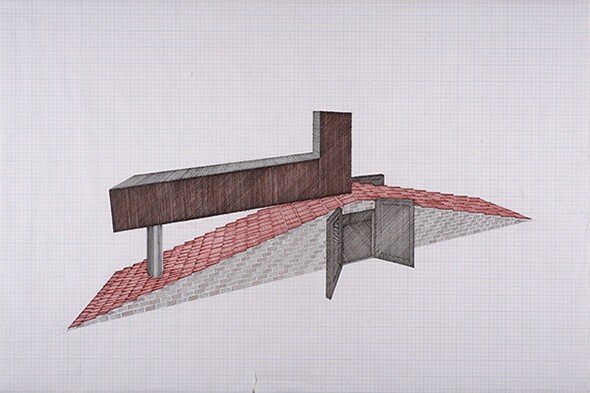April 15–May 27, 2016
Ab/Anbar Gallery
No.2 Roshanmanesh alley
Khaghani St., Enghelab St.
Darvazeh Dolat
Tehran
Iran
Hours: Sunday–Friday noon–8pm
Artists: Siah Armajani, Shahab Fotouhi, Babak Golkar, Shirazeh Houshiary, Y.Z Kami, Avish Khebrehzadeh, Arash Mozafari, Timo Nasseri and Newsha Tavakolian
Ab-Anbar is delighted to announce MASS INDIVIDUALISM: A Form of Multitude, a group exhibition examining the shifts occurring between public and private space through artworks that explore architecture’s role in facilitating such transformations.
Aristotle made a fundamental distinction between politics and economics, using two terms to differentiate them: techne politike as the faculty of decision-making for the public interest and techne oikonomike as the administration of the private space. Respectively, he drew a clear distinction between polis (cohabitation of human beings) and oikos (house), the two derivatives of “Politics” and “Economics.” In contrast to the clear distinction between the Hellenic oikos and polis, our contemporary society is a witness to a distorted distinction between the two. At the heart of this exhibition is a view that in the modern world, through the politics of the nation-state, a new realm arises, “a curiously hybrid realm” called “society,” where private enters the public realm, but without an orientation towards res publica, “the public thing,” or public interest (Hannah Arendt, 1998).
The exhibition is framed through four themes on the formations of public space. Firstly: public, action and speech, highlighting the importance of the human voice and its presence through Siah Armajani’s Tomb for Neema (2014) and Avish Khebrehzadeh’s Edgar + Theatre III (2010). Armajani’s “The Tomb Series” embodies humanistic, democratic and populist ideals that have defined his multifaceted vision for over 40 years that culminated in the creation of his own tomb. Khebrehzadeh’s capsulized public space, Edgar +Theatre III, brings together action and speech in quest for a web of relationships among individuals. In this web, however, there is no audience within the space and the actions are voiceless. Babak Golkar, on the other hand, takes us through the introduction of form in urbanism and the concept of multitude and mass ornamentalism of individuals in the modern era. This then proceeds into a discourse centered on technological revolution through an examining of the effect of technology on mass production and, thus, its effect on the economies of space and participatory role of individuals in it as explored through Timo Nasseri and Shahab Fotouhi/Arash Mozafari’s redefinitions of muqarnas (ornamental vaulting) as parametric forms. Technology and its fascination with the production of form brings us to our fourth theme: interior urbanism, with Golkar’s furniture seen as a sign of merged interior and exterior spaces and thus interwoven private and public domains. This theme is supported by Shirazeh Houshiary and Newsha Tavakolian’s take on capsular modes of living, hinting at the dawn of capsular civilizations, an urban phenomenon defining new privatized modes of public life. Finally, Y.Z Kami’s individual portraits painted on the ruins of a giant brick wall recalls the quest for immortality of the ancient Fayum mummy portraits, as well as Rem Koolhaas’s popular definition of modern living conditions, which have turned us all into “voluntary prisoners of architecture” (Van Schaik & Macel, 2005).
Faced with staggering technological advances, the suburbanization of our daily lives, and the extreme polarization of society, we are compelled to return to the capsules of vehicles, architectural cocoons, etc. as exemplified by the explosion of shopping malls, gated communities and amusement parks, raising questions including: What is public and what is private? Are we on the verge of defining a new “public realm?” Are our privatized capsules the new “public?” If so, where does art stand in relation to this new concept of “public realm?”
Biography
MASS INDIVIDUALISM: A Form of Multitude is curated by Azadeh Zaferani, an Architect, Urban Designer and researcher who lives and works between Tehran and Toronto. Zaferani is the founding director of Platform 28 for Art and Architecture where varied architecturally-drive research projects and activities take place.
For detailed biographies on artists, images and further information contact: press [at] ab-anbar.com

